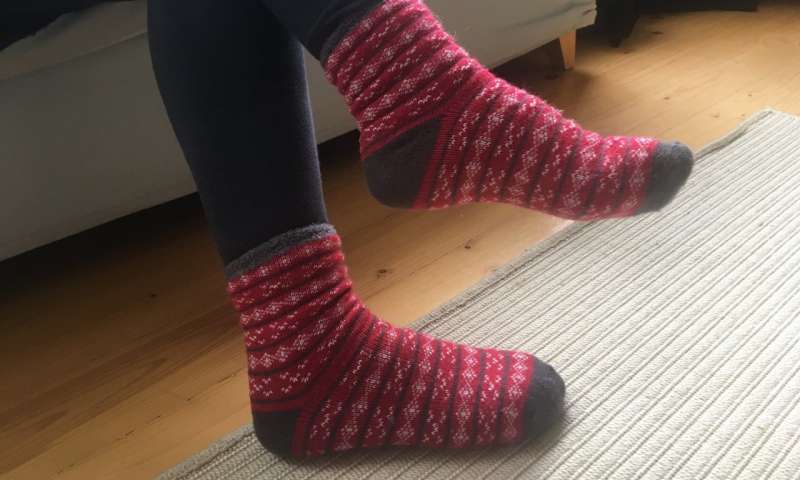The fluff from my new polyester socks is made of lots of tiny plastic fibres – and these so-called “microfibres” are a newly recognised source of marine pollution. Credit: Fauna & Flora International
I bought some new socks this week. So what, you might ask. My new socks are lovely and warm and very fluffy – just right for autumn. But, when I wore them, they moulted their fluff all over my feet, and if I'm not careful they will also lose fluff into my washing machine. Again, you may ask – so what? Well, all of this soft fluff isn't actually as "soft and fluffy" as you might imagine; in fact the fluff from my new polyester socks is made of lots of tiny plastic fibres – and these so-called "microfibres" are a newly recognised source of marine pollution.
There is growing evidence that when we wash our "synthetic clothing" (often plastic or plastic-mix clothes) – be they an acrylic jumper, a nylon coat or a polyester fleece (or indeed my socks) – they can release scores of tiny plastic fibres, which frequently travel unhindered through wastewater systems to our rivers and oceans.
Unfortunately, research suggests this isn't a tiny problem. An average wash of acrylic fabrics may release over 700,000 plastic microfibres. Think about how many domestic washes take place on any one day and you have an idea of the scale of the problem. It is estimated that 190,000 tonnes of plastic microfibres may be released each year; this makes them the third largest direct source of microplastic pollution to our oceans.
Domestic washing machines are just one source of such plastic microfibres. They are also released throughout the clothing production phases – be it dying, weaving or cutting of textiles – and from fishing nets and marine ropes, wet wipes, nappies and other seemingly innocuous sources. All these microfibres streaming into our oceans add to the growing pressure of plastic on marine life.
Plastic microfibres have been found inside a wide range of marine creatures; not just coastal species, but also those brought back from the ocean's deepest trenches. Microfibres have been found in animals such as langoustine, bass and mussels – the very seafood that you or I might enjoy eating and that provides food for thousands worldwide. Like other ocean microplastics, fibres can attract chemicals from the surrounding water, passing toxins to the animals that eat them and creating a route for contamination of marine foodchains.
So what are the solutions? Obviously, we need to wear clothes. And whilst wool, bamboo, silk and cotton are tempting natural alternatives to plastic, they do not always offer the same properties, cannot meet ever-growing global demand, and come with their own (sometimes significant) environmental challenges. How about the seemingly virtuous clothing lines created from recaptured ocean plastics? Guess what? When they are washed, their plastic fibres just end up back in the sea again.
Fauna & Flora International's (FFI) marine plastics team has been looking at this issue in some detail. Some proposed solutions – such as large-scale technological fixes in wastewater systems – just do not seem realistic. We believe the main answers must lie with the businesses that produce or handle the clothing; particularly when we know that plastic microfibre release during production may be as important as through domestic washing. The evidence suggests that careful design of the underlying fibres and yarns used to make fabric may be one way to limit the escape of plastic microfibres to the ocean.
It's clear that some sections of the clothing industry are all too aware of the problem, and a consortium of outdoor brands and high street clothing retailers are already working together with researchers to seek solutions. Effort to uncover the factors causing a piece of clothing to shed microfibres aims to provide clear guidance for industry on reducing the "shed risk" of clothes. However, we see a lack of engagement across the full chain of clothing production and use. As well as clothing brands and retailers, we want to see washing machine designers and, importantly, the textile industry tackling this issue.
So what can I do – as someone who inevitably wears and washes clothes – to stop adding to the plastic burden in our oceans? I have tried using a "Guppy Friend" mesh bag, one of two in-wash solutions suggested to capture microfibres. This was an expensive investment, and to date it hasn't caught any microfibres – at least none I can see. So, I am left asking myself some fundamental questions. How many clothes do I really need? Have I checked what a garment is made of before I buy it? Would wool or cotton actually be a better option, taking into account the full environmental burden of those industries? Do I need to wash my clothes quite so often? Can I wash them more gently so fewer fibres are released in the wash (perhaps helping my clothes to look newer for longer)?
Our wider research has shown me that so-called alternatives to plastic are not always straightforward. The same is true for plastic clothing – identifying alternatives to plastic that can work at scale is not easy. Thus, alongside reducing its use, we do need to seek ways to stop plastic shedding. In time, we are hopeful that the industry can collectively rise to the plastic microfibre challenge. FFI will certainly continue to work with a range of businesses, researchers and NGOs to help develop the solutions we need.
In the meantime, I have learnt my lesson from those socks, and will be reading the garment labels with more care in future.
Provided by Fauna & Flora International
























